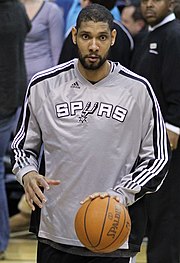Power forward: Difference between revisions
No edit summary Tags: Mobile edit Mobile web edit |
Moundzilla (talk | contribs) 6'6" to 6'7" is undersized for a PF which is why Charles Barkley is always mentioned as one of th best undersized PF players and he's at that height. Tags: Mobile edit Mobile web edit |
||
| Line 4: | Line 4: | ||
The '''power forward''' ('''PF'''), also known as the '''four''', is one of the five [[Basketball position|positions]] in a regulation [[basketball]] game. Power forwards play a role similar to that of [[center (basketball)|center]]. They typically play [[Offense (sports)|offensively]] with their backs towards the basket and position themselves [[Defense (sport)|defensively]] under the basket in a [[zone defense]] or against the opposing power forward in [[man-to-man defense]].<ref>{{cite web|url=http://www.nba.com/canada/Basketball_U_Players_and_Posi-Canada_Generic_Article-18037.html|title=NBA.com - Players and Positions|website=www.nba.com}}</ref> The power forward position entails a variety of responsibilities, one of which is [[rebound (basketball)|rebound]]ing. Many power forwards are noted for their mid-range jump-shot, and several players have become very accurate from {{convert|12|to|18|ft|m}}. Earlier, these skills were more typically exhibited in the European style of play. Some power forwards, known as [[stretch four]]s, have since extended their shooting range to [[three-point field goal]]s. |
The '''power forward''' ('''PF'''), also known as the '''four''', is one of the five [[Basketball position|positions]] in a regulation [[basketball]] game. Power forwards play a role similar to that of [[center (basketball)|center]]. They typically play [[Offense (sports)|offensively]] with their backs towards the basket and position themselves [[Defense (sport)|defensively]] under the basket in a [[zone defense]] or against the opposing power forward in [[man-to-man defense]].<ref>{{cite web|url=http://www.nba.com/canada/Basketball_U_Players_and_Posi-Canada_Generic_Article-18037.html|title=NBA.com - Players and Positions|website=www.nba.com}}</ref> The power forward position entails a variety of responsibilities, one of which is [[rebound (basketball)|rebound]]ing. Many power forwards are noted for their mid-range jump-shot, and several players have become very accurate from {{convert|12|to|18|ft|m}}. Earlier, these skills were more typically exhibited in the European style of play. Some power forwards, known as [[stretch four]]s, have since extended their shooting range to [[three-point field goal]]s. |
||
In the [[NBA]], power forwards usually range from 6′ |
In the [[NBA]], power forwards usually range from 6′ 8″ (1.98 m) to 6′ 10″ (2.08 m) without shoes while in the [[WNBA]], power forwards are usually between 6′ 0″ (1.83 m) and 6′ 3″ (1.91 m). Despite the averages, a variety of players fit "[[Tweener (basketball)|tweener]]" roles which finds them in the [[small forward]] or center position depending on matchups and coaching decisions.<ref>{{cite web|author=Scott Burns|url=https://syndication.bleacherreport.com/amp/1480043-ranking-the-nbas-best-tweeners.amp.html|title=Ranking the NBA's Best "Tweeners"|publisher=[[Bleacher Report]]|date=January 11, 2013|accessdate=March 26, 2020}}</ref> Some power forwards often play the [[Center (basketball)|center]] position and have the skills, but lack the height that is usually associated with that position. |
||
Power forwards that are inducted in the [[Naismith Memorial Basketball Hall of Fame]] include [[Karl Malone]], [[Denise Curry]], [[Dolph Schayes]], [[Kevin McHale (basketball)|Kevin McHale]], [[Charles Barkley]], [[Elvin Hayes]], [[Bob Pettit]], [[Dennis Rodman]], [[Katrina McClain Johnson]], [[Tim Duncan]], and [[Kevin Garnett]]. |
Power forwards that are inducted in the [[Naismith Memorial Basketball Hall of Fame]] include [[Karl Malone]], [[Denise Curry]], [[Dolph Schayes]], [[Kevin McHale (basketball)|Kevin McHale]], [[Charles Barkley]], [[Elvin Hayes]], [[Bob Pettit]], [[Dennis Rodman]], [[Katrina McClain Johnson]], [[Tim Duncan]], and [[Kevin Garnett]]. |
||
Revision as of 06:29, 20 May 2020

The power forward (PF), also known as the four, is one of the five positions in a regulation basketball game. Power forwards play a role similar to that of center. They typically play offensively with their backs towards the basket and position themselves defensively under the basket in a zone defense or against the opposing power forward in man-to-man defense.[4] The power forward position entails a variety of responsibilities, one of which is rebounding. Many power forwards are noted for their mid-range jump-shot, and several players have become very accurate from 12 to 18 feet (3.7 to 5.5 m). Earlier, these skills were more typically exhibited in the European style of play. Some power forwards, known as stretch fours, have since extended their shooting range to three-point field goals.
In the NBA, power forwards usually range from 6′ 8″ (1.98 m) to 6′ 10″ (2.08 m) without shoes while in the WNBA, power forwards are usually between 6′ 0″ (1.83 m) and 6′ 3″ (1.91 m). Despite the averages, a variety of players fit "tweener" roles which finds them in the small forward or center position depending on matchups and coaching decisions.[5] Some power forwards often play the center position and have the skills, but lack the height that is usually associated with that position.
Power forwards that are inducted in the Naismith Memorial Basketball Hall of Fame include Karl Malone, Denise Curry, Dolph Schayes, Kevin McHale, Charles Barkley, Elvin Hayes, Bob Pettit, Dennis Rodman, Katrina McClain Johnson, Tim Duncan, and Kevin Garnett.
References
- ^ "ESPN.com's Greatest Power Forwards". ESPN. ESPN Internet Ventures. June 2, 2005. Retrieved June 17, 2007.
- ^ Rosen, Charley (July 18, 2005). "Best all-time power forwards". Fox Sports. MSN. Archived from the original on July 19, 2005. Retrieved January 31, 2008.
- ^ DuPree, David (June 7, 2007). "Tim Duncan: Best power forward ever?". USA Today. Gannett Company. Retrieved June 17, 2007.
- ^ "NBA.com - Players and Positions". www.nba.com.
- ^ Scott Burns (January 11, 2013). "Ranking the NBA's Best "Tweeners"". Bleacher Report. Retrieved March 26, 2020.

